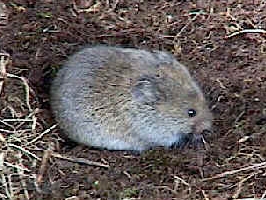
Form and Function
The California Meadow Vole’s physical appearance varies
depending on where they live. Microtus californicus has a lot of variation
when it comes to the size of the vole. Species found in the
south are usually much larger than those found in the north
(ADW 2002). This is due to the different types of habitats
the voles occupy and specific predators. In the northern part of
California the total length of the vole varies between 139 and
207 mm (ADW 2002). The male California Meadow Vole always
weighs more than the female. The male vole weighs between 33 and
81 g with an average of 52 g. The female vole weighs between 30
and 68g with an average of 47g (ADW 2002). A size comparison
to the vole would be bigger than a household mouse but smaller
than a rat.

The coat of these small mammals also depends on the habitat the
species lives in. The range of their coat colors is from a light
brown, to a brownish gray, to a dark brown depending on their
surroundings. The California Meadow Vole has had changes in their
coat color to help them blend in with their surroundings to avoid
predators. They also can be more of a reddish color in the desert
or even black towards the coast. The feet of this
small mammal are very pale and their eyes are very dark brown to
black (ADW 2002). The California Meadow Vole has a very
stocky body, very short legs, and quite small rounded ears
(Vertebrate Pest Control Handbook 2009).
The
California Meadow vole is active during both the day and night
(Vertebrate Pest Control Handbook 2009). They only come out of
their burrows in which they live in to feed, urinate, and
defecate (Cudworth and Koprowski 2010). The average amount of
time spent in these runways each time their used is 7 minutes
during the daylight and 1 minute during night time. The average
amount total spent in these burrows in a day is 1.7 hours
(Cudworth and Koprowski 2010). In order to get around they dig
small tracks in the ground and use these as runways (ADW
2002). All meadow voles are also able to swim well even though
they are very small mammals. (Vertebrate
Pest Control Handbook 2009).
Next, read about the Reproduction of the California Meadow Vole.